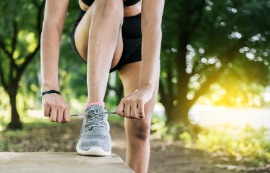 According to research, many people, including adults and children, wear the wrong type of footwear. In particular, children with certain neurodevelopmental disorders, people with diabetes, and older individuals are more likely to wear shoes that are too tight.
According to research, many people, including adults and children, wear the wrong type of footwear. In particular, children with certain neurodevelopmental disorders, people with diabetes, and older individuals are more likely to wear shoes that are too tight.
This problem is associated with foot pain, foot disorders, and abnormalities, such as corns, calluses, and lesser toe deformities. One of the main reasons that people wear improper shoes is because they may not realize that different types of shoes are made for specific activities. Let’s take a closer look at shoes that are designed for various purposes.
Walking Shoes
Walking shoes are one of the most commonly purchased types of footwear. Whether people walk for relaxation or physical fitness, this is an ideal form of exercise. In addition, walking is a low-impact activity that is easy on the joints, but it is still important to wear appropriate shoes for walking.
Walking shoes are usually lightweight and offer ideal support for the feet due to special soles that help people roll their feet as they walk. The rolling motion while walking is more efficient than stepping heel to toe, and walking in this manner minimizes the impact on the joints. Individuals who walk regularly for fitness need to invest in a quality pair of walking shoes. Choosing the right type of shoe helps people walk faster, further, and with a lower risk of injury. However, walking shoes that fit properly, are not too narrow or too long, and offer sufficient arch support. Proper arch support is essential to maintaining good posture and balance.
Running Shoes
Running shoes are different from walking shoes as they are designed to protect the ankles and feet from the impact of running through specialized cushioning and arch support. This type of shoe also provides traction while running on uneven surfaces, which makes it easier to run on challenging terrains, such as trails. A good pair of running shoes is an important investment, particularly for avid runners.
An important point to remember is that walking shoes are not a substitute for running shoes. Therefore, it is vital to wear shoes that accommodate a specific activity to avoid unexpected injuries.
Sports Shoes
High-impact sports, such as football, basketball, tennis, etc., require rapid movements and quick direction changes. Due to these factors, athletes may experience foot and ankle injuries. The risk of injury further increases when incorrect shoes are worn during sports activities. Wearing shoes that are designed for a particular sport helps minimize the incidence of injuries by providing high-intensity cushioning as well as foot and ankle support.
Most sports shoes have reinforced side panels and additional padding that provide extra protection from quick movements. The specific design also promotes a more balanced distribution of the arch, sole, heel, and toe to reduce the risk of sports injuries. Sports shoes may also have special grips, such as cleats that are often worn by football players, to help prevent slipping. Special grips also improve traction and performance.
Gym-Athletic Shoes
Gym or athletic shoes provide optimal stability and support for high-intensity interval training (HIIT) programs. They are particularly helpful at protecting the feet from the impact of hard surfaces while running and jumping. Furthermore, for people who are lifting weights, performing aerobics, doing box jumps, or engaging in other types of vigorous exercises, athletic (gym) shoes can help lower the risk of foot injuries by offering optimal traction. These types of shoes typically have hard soles that distribute weight during exercise, evenly disperse the force of lifting a heavy object, and prevent the feet from sliding forward.
Shoes for Rock Climbing
Shoes that are designed for rock climbing provide extra foot support, flexibility, and traction while climbing. These types of shoes usually have a flat base and a stiff, rubber sole that helps the foot grip the rock’s surface. Rock-climbing shoes are also usually made from mesh that creates a snug fit around the ankle area to help prevent the foot from moving around inside of the shoe while scaling the rocks.
Consider Speaking With a Physical Therapist
If you’re experiencing ongoing foot pain or you need assistance in choosing the appropriate pair of shoes, a Physical Therapist at Pearland, Houston can provide a comprehensive evaluation and professional guidance. Understanding when to wear certain shoes is one of the keys to preventing foot problems, maintaining ideal health, and getting the most out of the activities you enjoy. Schedule a consultation today with one of our expert Physical Therapists who can access your current footwear and offer useful suggestions for your next pair.
References
1. Buldt AK, Menz HB. Incorrectly fitted footwear, foot pain and foot disorders: A systematic search and narrative review of the literature. J Foot Ankle Res. 2018;11:43.
2. Frey C. Foot health and shoewear for women. Clin Orthop. 2000;372:32-44.
3. Richards R. Calluses, corns, and shoes. Semin Dermatol. 1991;10(2):112-114.
4. Chantelau E, Gede A. Foot dimensions of elderly people with and without diabetes mellitus–a data basis for shoe design. Gerontology. 2002;48(4):241-244.
5. Huang Y, Peng HT, Chen ZR, et al. The arch support insoles show benefits to people with flatfoot on stance time, cadence, plantar pressure and contact area. PLoS One. 2020;15(8):e0237382.
6. Wannop JW, Worobets JT, Stefanyshyn DJ. Footwear traction and lower extremity joint loading. Am J Sports Med. 2010;38(6):1221-1228.
7. Andreasson G, Lindenberger U, Renstrom P, Peterson L. Torque developed at simulated sliding between sport shoes and an artificial turf. Am J Sports Med. 1986;14(3):225-230.
8. Lambson RB, Barnhill BS, Higgins RW. Football cleat design and its effect on anterior cruciate ligament injuries: A three-year prospective study. Am J Sports Med. 1996;24(2):155-159.